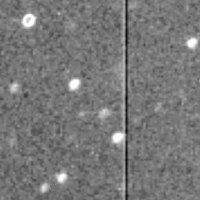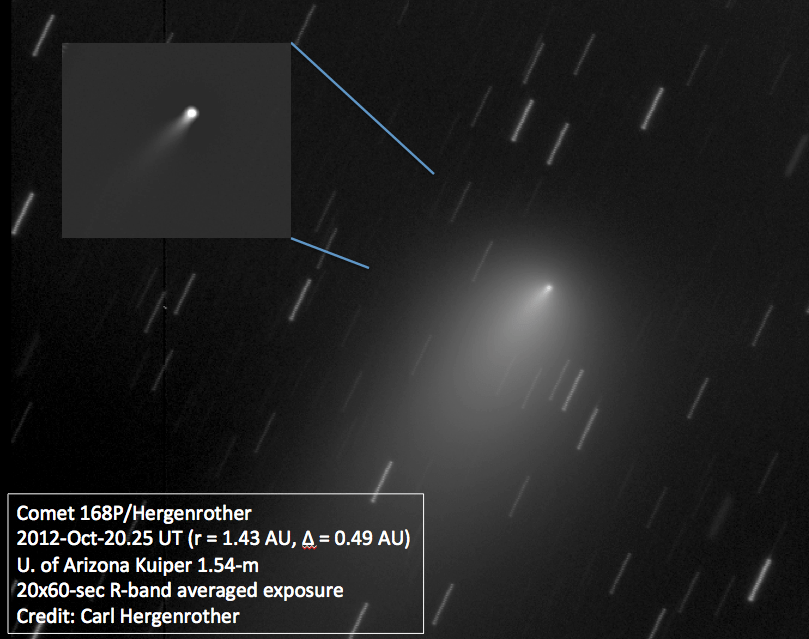Fourteen years ago, a 25 year old version of myself stumbled across a faint new comet in the constellation of Aquarius. Circling the Sun every ~7 years, the comet is intrinsically faint and could be rightly considered a runt. This year the comet was perfectly placed with perihelion and opposition occurring within days of each other (perihelion on October 1). As a result this comet which only comes within 1.41 AU of the Sun is also passing within 0.42 AU of Earth. Based on its previous behavior it should have only brightened to 14-15th magnitude which is nothing special. Surprisingly it has experienced a series of outbursts and is now bright enough to be seen in small telescopes or even binoculars at magnitude 9.2 to 9.8.

I’m probably one of the last people to write about the outburst of comet 168P/Hergenrother which is surprising since it’s one of my finds. It was discovered on images taken with the Catalina Schmidt (then a 0.41-m) telescope during the course of the Catalina Sky Survey (CSS). It was the 2nd of my four comet discoveries and my first CCD find [my first comet, C/1996 R1 (Hergenrother-Spahr) was found with photographic film]. Though I was the first to spot the comet the actual images were taken by either me, John Brownlee and/or Tim Spahr. Discovery images can be seen to the right. It’s not much to look at and the bad column sure didn’t help.
At that time, the CSS had just finished upgrading the Schmidt from a photographic instrument to a digital CCD equipped instrument. We still had a ways to go and didn’t even have automatic detection software yet. Instead we would take 3 images spaced about 10-15 minutes apart and difference (subtract one image from another after lining them up relative to field stars) 2 of the images. Objects that didn’t move such as stars would mostly disappear leaving a positive and negative spot for moving objects. We would then blink all three of the original images to make sure our suspects were real objects. It was highly inefficient but resulted in a few new near-Earth asteroid and comet discoveries before the automated detection system was available.
The 2012 return started routinely wit the comet brightening up to its expected 15th magnitude. The first sign of outburst activity was reported by J. J. Gonzalez (Spain) who visually sighted 168P at magnitude 11.2 on September 6. A second outburst must have occurred around the start of October. By October 3rd, observers such as Michael Mattiazzo (Australia) were reporting the comet at magnitude 9.8. Over the last few weeks brightness estimates have ranged between 9.2 and 10.0.
My own estimates are given below:
Oct. 11.10, 9.2, 6′ (C. W. Hergenrother, Tucson, Arizona, 30×125 binoculars);
Oct. 09.13, 9.6, 6′ (C. W. Hergenrother, Tucson, Arizona, 30×125 binoculars);
Oct. 08.19, 9.3, 3′ (C. W. Hergenrother, Tucson, Arizona, 30×125 binoculars);
Oct. 04.10, 9.8, 1.5′ (C. W. Hergenrother, Tucson, Arizona, 30×125 binoculars);
Oct. 04.10, 9.9, 2′ (C. W. Hergenrother, Tucson, Arizona, 0.31-m reflector).
The comet was easy in 30×125 binoculars from my backyard (LM = +5.7-6.0). Though the comet was visible in 10×50 binoculars it was hard to make an accurate brightness estimate due to the dense star field. My yard is fairly dark for a suburban site. If you live under brighter skies a larger telescope will be required to see the comet.
Since the start of its outbursts, the comet has looked relatively normal in CCD images with no sign of jets or secondary nuclei. Yesterday, Gianluca Masi (Italy) emailed me with images showing a ‘cloud’ of material tailward of the nucleus. Luckily I was scheduled on the University of Arizona’s Kuiper 1.5-m telescope and was able to confirm Gianluca’s observation. The image below shows the “cloud” trailing the nucleus in the anti-solar direction.
.
So what’s happening? Luckily we saw something similar back in 2006 when comet 73P/Schwassmann-Wachmann 3 made a close approach to Earth. SW3 had undergone a splitting event back in 1995 which produced two major components (the original nucleus and a smaller secondary one). The smaller component (called 73P-B) was still experiencing outbursts and shedding material in 2006. From time to time, “clouds” of material would appear to drift back from the nucleus. High-resolution images showed this “cloud” to be composed of hundreds of small mini-comets, many probably no larger than a meter in size. As these mini-comets disintegrated they would produce short-lived mini-comae that lasted for only a day or so.
Look familiar?

.
Only a few weeks later the Hubble Space Telescope and ground-based telescopes such as the Vatican 1.8-m were able to resolve 73P-B’s “clouds” into a group of hundreds of mini-comets. More images of 73P-B taken with the SAO 1.2-m, Kuiper 1.5-m and VATT 1.8-m can be found here.

.
Could the same thing be happening with 168P? Possibly. Right now we aren’t sure what is exactly going on with 168P. The fact that the comet is experiencing outbursts means it is releasing a large amount of dust. It is very possible that it has also released a number of meter sized boulders. These boulders may be releasing dust causing the “cloud” visible trailing the main nucleus. Perhaps larger telescopes will provide better images over the coming weeks.
In the meantime, the comet is still visible to small telescope users as it moves northward from Pegasus to Andromeda. A finder chart can be found at Comet Chasing.
I can’t lie that I’ve had been waiting for this apparition of 168P and hoping it would become bright enough to be seen visually. As both an amateur and professional astronomer I still get a thrill seeing a comet with my own eyes. Having it be one of mine makes it even better. (Of my four discoveries, this is the 2nd I’ve been able to see visually. C/1996 R1 was 10th magnitude at discovery.) I look forward to seeing what other surprises 168P throws our way.
Good job, little 168P!



Great write-up, Carl!
hi. i think your blog post is interesting, but i noticed that you said that we`re not exactly sure what is going on with 168p, and i understand that you`re probably referring to it`s outbursts, but the statement raised a question in my mind, namely, could this comet or the accompanying comet c/ 2012 j1 (catalina) impact the earth, or are there any other comets scheduled to come near earth this year which could (realistically, not just theoretically) impact the earth? thank you for answering my question.
Bill, comet fragmentation is a common event and is not dangerous. When comets fragment they generally separate at rate of 3-7 meters a second and this is why it can take from a week to a month for the lesser secondary fragment to be visually seen separate from the parent body (depending on the telescope and viewing angles). The fragment of 168P was confirmed by the 2 m (79 in) Faulkes Telescope North on 26 October 2012.
Comet C/2012 J1 comes no closer to the Sun than 3.1 AU, which is more than 3 times the distance of Earth from the Sun. C/2012 J1’s closest approach to the Earth was on 2012-Oct-16 at a distance of 2.33231 AU.
— Kevin Heider
I saw a Halloween Fireballl @ 6:10am here in Tennessee
Im from Nashville Tn and I have been seen several times comets fragments , and Im wondering if there is something going on out here in the space that we should be aware , Im a little scare that we get hit by an comet .Please some one respond me about this
People are more aware of comet fragmentation now than they were hundreds of years ago because we have access to better telescopes and CCD detectors.